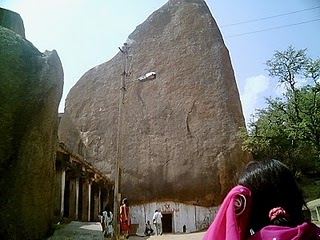
The name of the place Chitradurga, brings into the mind a majestic fortress of the city. A tour to that district is planned with a time span of 2-3 hours. To emphasize the fact that "Chitradurga Fort" is a Historical monument of National importance, we have the Govt of India office before we enter the "Third wall" of the Seven walled Fort. There is a small entrance fee. There are well-dressed guides right at the entrance. They ask about our convenient time span for the tour and show around the Fort in that duration. Only when asked about the nearby places, do some of them who are actually interested in this fascinating historical place, tell us about the "other" tourist places of the district.
In the list of about 6-7 nearby places, we decided to go to the nearest one which could be covered in about an hour. Exactly about 6-8kms away from the magnificent Fort, lies a greater defensive location for the Royal families, especially those who went into hiding after losing a battle. The name of the place is "Chandravalli". If it rings a bell, then there has been a Kannada movie shot with the same name. And for more reference, this area was one of the locations for a few scenes in another Kannada movie.
The region is a semicircular shaped valley formed by three hills, Chitradurga, Kirabanakallu and Cholagudda, and Chandravalli is an ancient historical site located in the western part of the Chinmuladri hills. Excavations here have shown that this place was inhabited since Iron age. Surrounded by hills with a lake in the middle, makes it a beautiful location.
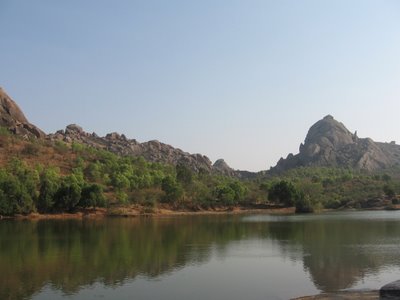
As one climbs towards the Caves, there is a pretty big and beautiful lake which greets us. After the cool breeze hitting the face and refreshing you after a small journey, there is a small trek uphill. There are no proper steps available. There is no entrance fee or well-dressed guides. One may find a tattered board which says "Historical Monument. Defacing it will invite fine from the Govt. of Karnataka." The trust closes at 5pm, as sharp as any Govt. Office. If you let these things hold you back from going further, then you are probably giving up a chance to see a historical marvel right just a few feet away.
First sight which catches the eye when one reaches the top of this hill (or rather hillock) are giant monolithic rocks on either side of the landing. Entering to the left, one can get an idea about the caves that these hills hold. Dark and damp inside, but totally unscratched are nine Shiva Lingas. Each time a sage came to this place, either for meditation or for hiding, established a Shiva Linga for their puja. Thus, the beauty of symmetry in this place is that, count from either end of the room, there are similar shaped and sized Lingas on opposite ends of the room which end at the same central big Linga.
Stepping out of the Shiva temple, to the left (or straight from the climb of hillock), we enter the main cave. Posing like a normal cave from outside, there are wonders and secrets hidden in the heart of this cave. There is a main Dwara (door) with a carving of Shiva's vehicle Nandi. Thus Nandi is the first guardian to this cave. Once we enter this door, there is a room similar to the concept of Sitting rooms. Here the persmission is sought to meet the important Sage or King inside. Only then people were allowed to pass through the next door. This is the Simha Dwara (Lion's door) which leads to a main room for Gurukula and prayers. To enter the Gurukula room, one must step down exactly 7 steps. Once inside the room, there is a prominent Peetha (seat) for the teacher and a gathering place on the ground in front of it for the students. Everyday before the learning began, all disciples would pray to another Shiva Linga in the same room.
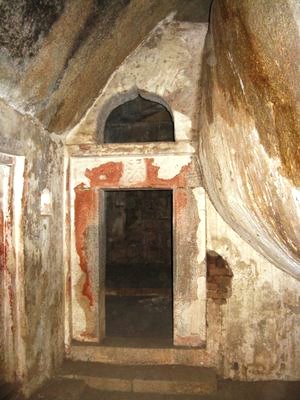
After the seven steps are climbed down, it becomes extremely dark and impossible to see the path ahead. Following this room, the paths are all narrow and crooked. Thus it requires people to walk one behind the other. Suppose there are 5 people in the group. The darkness is so intense that, the torch light held by first person cannot light the path at the foot steps of fifth person.
Next, once through another door of the Gurukula room, there was a small room which acted as another landing. Once anyone arrives here, they are bound to get lost in the caves after this. This is the first defensive mechanism in these caves. The door from which one enters the landing appears exactly similar to other 6 doors which leave this room. If one lets their concentration wander for a moment, they wouldn't be able to remember which way led inside and which may lead out. It was said that once the enemy troops attack this cave, the soldiers here would warn the kings and then make themselves seen in this room. By trying to follow these "seen" soldiers of the hiding royal family, the other soldiers remain roaming around the same area through the similar seven doors.
Thus a guide in this cave who knows it in-and-out is very much advisable. Once we move through the right door we come to the next chamber. A low head space is a common characteristic from this chamber onwards. First we reach the royal bathroom. The concept of a shower closet and Rain Water harvesting are being claimed as the new inventions these days. But lying hidden in this cave is the proof that it was available many many centuries ago. A small corner portion of the room has a half wall built to form a shower closet. Next this is a big water storage tank. The water to this tank is the rain water filtered through the rock layers through an opening on the top of the monolithic rocks. Other source of water is the clear water running in the Chandravalli lake right at the base of these rocks at the entrance.
The inner architecture of this room gives a good introduction to the building methods adopted in these caves. A mixture of clay, lime, egg yolk, etc were mixed and allowed to strengthen over many months. At the end of the process they provided a strong cement-like material which shines much brighter than white marble. This cement-like plaster has intricate carvings all over it for decoration purposes. These carvings have been painted in many colours obtained by plant extracts. Following this room is the Bedroom of the Sage/ King.
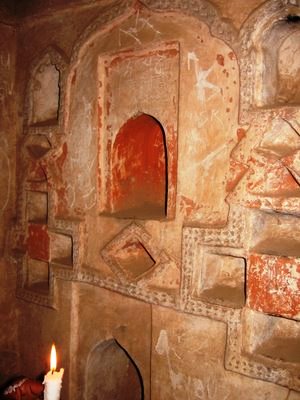
The bedroom has a nice wide Rock bed. The roof of this chamber has been carved in the form of an Arch so that it does not touch the head of the person who is using the bed. The room has two air ventilators. One ventilator to provide fresh incoming air and the other ventilator for the air to go out of the chamber. Here is the second defensive mechanism for the Kings. Once an attack from the enemy has been sounded, the Kings could escape from this room to an interior secret chamber. The path to the interior chamber is another interesting thing to mention. As mentioned, the bedroom has two ventilators for air passage. Through the outlet ventilator, a person can throw something (say matchbox) and move forward.
In a slightly enclosed manner, there is a door which leads out of this bedroom. It has stairs which lead downwards. These stairs have a height which one has to sit and jump. Again the roof here would hit a person's head if not crouched down to about 5" height. At this point, when asked why all the doors have such small heights, the guide would probably laugh and say the Cholas who built this cave were people of average height 5", hence the architecture of the whole cave is made to the comforts of short people.
While climbing down these steep stairs, one can get the feeling of being dragged into an underground chamber. After stepping down a couple of stairs, we are at least 60 feet below the ground level, which is exactly the depth of Chandravalli lake. Thus, we were walking at par with the lake bed. Wouldn't it be enough to hear that and feel the nostalgia? But the entire air passage ventilators and chambers are built/ drilled in such a way that there wasn't much to feel nauseous about. Only due to the fact that the these caves have not been resided in for the last many decades and due to the unkept surroundings, a whole lot of bats hanging upside down in the cool and dark caves can be found. Due to the presence of bats and the dampness of water under the lake bed there is a stench which gets notified to our sensitive noses if given attention to. Mid-way through the flight of stairs, there is a third defensive mechanism. It is rather a escape mechanism into the surrounding jungles when an attack on the caves occurred. This route has been currently sealed due to the presence of wild animals even till date in the jungle of surrounding areas. There is a ventilator at the roof of this landing, through which we had thrown something (say the matchbox). Pick up your stuff and walk away in the secret passage. This way one can save their valuables in case of sudden assault and pick them later and run outside.
After the steep climbing down, we reach a landing where the fourth line of defense is present. This is the place where an early warning of the attacking troop can be announced from. One can find a innocent looking hole in the wall. One look into the hole, and there is a sight of the entrance of the cave laid out in front of us. The whole of seven stairs after entering the second wall is seen from behind the Peetha of the Gurukula room. This way, one can sit and enjoy the unsuspecting troops of the enemy enter, get confused and roam around in circles, while the King and his family are given enough time to make their escape.
Past this chamber is the prayer hall. One will only have to guess that the chamber had a magnificent idol of a God. Thieves have somehow managed to enter this far into the cave and destroy the idol to take away the precious stones which were embedded into the walls, the floors and the roof close to the idol. Now, all that remains here is broken pieces of the Idol, magnificent intricate paintings on the sides and roof of the other parts of the chamber. Next through another passage from the prayer room, is the last and the inner-most chamber of the cave. Called the secret-meeting chamber of the cave, it was the place where the royal members and the important court men gathered and discussed secret strategies. In case of an attack, these important people came here, extinguished the lamps and sat in complete silence. The enemies could never even guess to take the deviation and come this far into the dark and silent secret chamber where all these people were hiding. Also this was the safety vault for most of the precious possessions of King and his warriors. The possessions were swords, daggers and knifes. The shape of the vaults give a clear idea of its contents which were stored in those times.
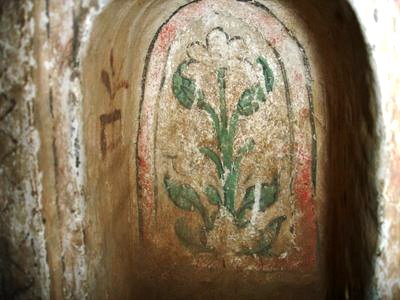
To demonstrate this, the guide warned about the darkness and the silence of the chamber. Once the torches were switched off, there was utter darkness. And the silence was so intense that the ears start humming inside one's head. At this time, there were people who were walking outside this chamber at the entrance or the next chamber, and their voices carried down till this chamber loud enough to warn of the incoming enemies.
Whew!! When it was announced that this was the last chamber of the caves, one may feel relieved to get out of this mysterious place and get a sight of sunshine. If one turns around to take the path through which they would probably be roaming around like the enemy warriors attacking the cave. While a person takes one path to enter the inner-most secret meeting chamber, they have to take a completely different path to go out of the cave. Taking this new path leads by climbing up a set of steep stairs again, one comes to the entrance chamber that is the Gurukula room.
As we walked outside, there were a few more people who were lucky enough to have asked about this place and come to visit it. They asked us about the place, whether it was worth the visit or could they forgo these caves. Our reply to them, and probably to all is "Well, this is one place which cannot be explained or imagined. This is something which one must see to marvel the architectural beauty of the place. You wont be disappointed by taking an extra hour or two to see these caves."
